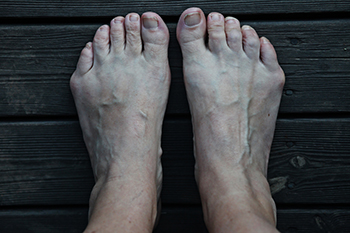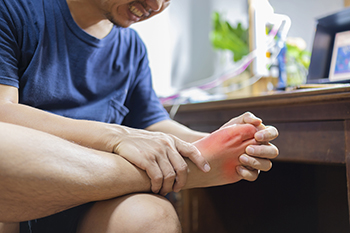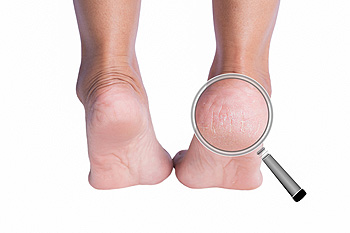Connect With Us
Blog
Items filtered by date: June 2022
What is a Bunionette?

A bunionette is a prominent deformity at the base of the fifth (or little) toe. It can be painful, particularly if it rubs against a tight-fitting shoe. This mini bunion occurs if the bone of the midfoot angles out and the little toe angles in, leading to a bony prominence. The toe might hurt on the outside or inside if that toe rubs against the fourth toe. Wearing wider shoes with space to accommodate the bump, wearing a toe spacer, or padding the bump will help prevent further irritation. Depending on the severity of the bump, it may be necessary to limit walking or standing. Surgery to remove the bunionette or reposition the baby toe are options when these do not work. If you have a bunionette, consult with a podiatrist who can take an X-ray to confirm the problem and provide treatment that is right for you.
If you are suffering from bunions, contact Dr. Royall of Mountain View Foot & Ankle Clinic. Our doctor can provide the care you need to keep you pain-free and on your feet.
What Is a Bunion?
A bunion is formed of swollen tissue or an enlargement of boney growth, usually located at the base joint of the toe that connects to the foot. The swelling occurs due to the bones in the big toe shifting inward, which impacts the other toes of the foot. This causes the area around the base of the big toe to become inflamed and painful.
Why Do Bunions Form?
Genetics – Susceptibility to bunions are often hereditary
Stress on the feet – Poorly fitted and uncomfortable footwear that places stress on feet, such as heels, can worsen existing bunions
How Are Bunions Diagnosed?
Doctors often perform two tests – blood tests and x-rays – when trying to diagnose bunions, especially in the early stages of development. Blood tests help determine if the foot pain is being caused by something else, such as arthritis, while x-rays provide a clear picture of your bone structure to your doctor.
How Are Bunions Treated?
- Refrain from wearing heels or similar shoes that cause discomfort
- Select wider shoes that can provide more comfort and reduce pain
- Anti-inflammatory and pain management drugs
- Orthotics or foot inserts
- Surgery
If you have any questions, please feel free to contact our office located in Lehi, UT . We offer the newest diagnostic and treatment technologies for all your foot care needs.
Gout Can Attack Your Big Toe

Gout is a condition caused by a buildup of uric acid directly related to foods that contain high levels of purines. The uric acid forms crystals that settle in the joints, commonly at the base of the big toe. This can cause sharp pain, inflammation, redness, and swelling. Foods that contain purines inhibit your body’s ability to shed uric acid properly. Men most often experience gout between the ages of 30 and 50, while women are more susceptible after the onset of menopause. Reducing the intake of purine-rich foods is a good way to prevent gout. Among them are beef, organ meats, certain types of seafood, as well as some vegetables and legumes. Drinking more water and less alcohol may also bring some relief. If you have developed gout, it is a good idea to see a podiatrist who can prescribe corticosteroids and other medicine to help reduce pain and uric acid levels.
Gout is a foot condition that requires certain treatment and care. If you are seeking treatment, contact Dr. Royall from Mountain View Foot & Ankle Clinic. Our doctor will treat your foot and ankle needs.
What Is Gout?
Gout is a type of arthritis caused by a buildup of uric acid in the bloodstream. It often develops in the foot, especially the big toe area, although it can manifest in other parts of the body as well. Gout can make walking and standing very painful and is especially common in diabetics and the obese.
People typically get gout because of a poor diet. Genetic predisposition is also a factor. The children of parents who have had gout frequently have a chance of developing it themselves.
Gout can easily be identified by redness and inflammation of the big toe and the surrounding areas of the foot. Other symptoms include extreme fatigue, joint pain, and running high fevers. Sometimes corticosteroid drugs can be prescribed to treat gout, but the best way to combat this disease is to get more exercise and eat a better diet.
If you have any questions please feel free to contact our office located in Lehi, UT . We offer the newest diagnostic and treatment technologies for all your foot and ankle needs.
Foot Pain in Kids

Beyond how active kids are, there are many reasons why children might complain of sore feet. A child may injure the foot resulting in a sprain or fracture. They may have athlete’s foot and find the skin in between their toes or the soles of their feet to be itchy, dry, and scaly. Kids experiencing growth spurts or who play sports involving running and jumping may complain of sore heels and this could be indicative of a condition called Sever’s disease. Children who are flat-footed may have foot pain that extends up to their ankles and calf muscles. Tight or ill-fitting shoes can cause blisters or corns. Kids can even develop bunions due to genetics or if the arch of their foot is overcompensated. Sometimes, if the toenails are clipped improperly, a toenail can dig into the surrounding skin and cause pain. Because children’s feet are so important to their overall functioning and each condition mentioned causes foot pain, it is suggested that a podiatrist be included as part of your child’s routine health care. A podiatrist can diagnose problems that arise and help direct the proper foot care of your child.
The health of a child’s feet is vital to their overall well-being. If you have any questions regarding foot health, contact Dr. Royall of Mountain View Foot & Ankle Clinic. Our doctor can provide the care you need to keep you pain-free and on your feet.
Tips for Keeping Children's Feet Healthy
- Make sure their shoes fit properly
- Look for any signs of in-toeing or out-toeing
- Check to see if they have Clubfoot (condition that affects your child’s foot and ankle, twisting the heel and toes inward) which is one of the most common nonmajor birth defects.
- Lightly cover your baby’s feet (Tight covers may keep your baby from moving their feet freely, and could prevent normal development)
- Allow your toddler to go shoeless (Shoes can be restricting for a young child’s foot)
- Cut toenails straight across to avoid ingrown toenails
- Keep your child’s foot clean and dry
- Cover cuts and scrapes. Wash any scratches with soap and water and cover them with a bandage until they’ve healed.
If you have any questions, please feel free to contact our office located in Lehi, UT . We offer the newest diagnostic and treatment technologies for all your foot care needs.
Why Dry Skin Can Lead to Cracked Heels

When the skin on your heels is allowed to become overly dry, rough, and thick, this can sometimes set the stage for cracked heels to develop. That is because when the weight of the body bears down—and the heel naturally spreads out—this callused, inflexible skin can crack. If cracked heels (heel fissures) are left untreated, they can deepen, become painful, and possibly even bleed or become infected. The best way to treat cracked heels is to avoid getting them at all. Applying topical emollients or occlusive moisturizers at night and covering your feet with socks can help seal in moisture and keep the heel hydrated. Also, gently massaging the heels with a pumice stone may help to smooth out mildly cracked heels, but this practice is not advised for people with diabetes or nerve damage. If your heels are badly cracked, red, painful, bleeding, or you believe they may be infected, it is suggested you contact a podiatrist to receive professional care.
Cracked heels are unsightly and can cause further damage to your shoes and feet. If you have any concerns, contact Dr. Royall from Mountain View Foot & Ankle Clinic. Our doctor can provide the care you need to keep you pain-free and on your feet.
Cracked Heels
Cracked heels appear unappealing and can make it harder for you walk around in sandals. Aside from looking unpleasant, cracked heels can also tear stockings, socks, and wear out your shoes. There are several methods to help restore a cracked heel and prevent further damage.
How Do You Get Them?
Dry skin is the number one culprit in creating cracked heels. Many athletes, walkers, joggers, and even swimmers suffer from cracked heels. Age and skin oil production play a role to getting cracked heels as well.
Promote Healing
Over the counter medicines can help, especially for those that need instant relief or who suffer from chronic dry feet.
Wear Socks – Wearing socks with medicated creams helps lock in moisture.
Moisturizers – Applying both day and night will help alleviate dryness which causes cracking.
Pumice Stones – These exfoliate and remove dead skin, which allows for smoother moisturizer application and better absorption into the skin.
Change in Diet
Eating healthy with a well-balanced diet will give the skin a fresh and radiant look. Your body responds to the kinds of food you ingest. Omega-3 fatty acids and zinc supplements can also revitalize skin tissue.
Most importantly, seek professional help if unsure how to proceed in treating cracked heels. A podiatrist will help you with any questions or information needed.
If you have any questions, please feel free to contact our office located in Lehi, UT . We offer the newest diagnostic and treatment technologies for all your foot care needs.
Arthritis Can Cause Pain in the Feet and Ankles
Blog Archives
- April 2025
- March 2025
- February 2025
- January 2025
- December 2024
- November 2024
- October 2024
- September 2024
- August 2024
- July 2024
- June 2024
- May 2024
- April 2024
- March 2024
- February 2024
- January 2024
- December 2023
- November 2023
- October 2023
- September 2023
- August 2023
- July 2023
- June 2023
- May 2023
- April 2023
- March 2023
- February 2023
- January 2023
- December 2022
- November 2022
- October 2022
- September 2022
- August 2022
- July 2022
- June 2022
- May 2022
- April 2022
- March 2022
- February 2022
- January 2022
- December 2021
- November 2021
- October 2021
- September 2021
- August 2021
- July 2021
- June 2021
- May 2021
- April 2021
- March 2021
- February 2021
- January 2021
- December 2020
- November 2020
- October 2020

